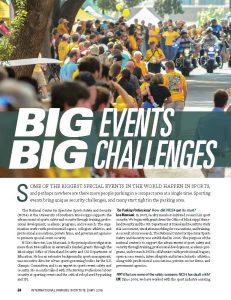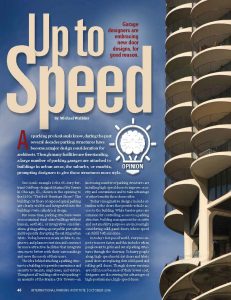How sport safety and security are greatly enhanced by parking and now, by IPI.
SOME OF THE BIGGEST SPECIAL EVENTS IN THE WORLD HAPPEN IN SPORTS, and perhaps nowhere are there more people parking in a compact area at a single time. Sporting events bring unique security challenges, and many start right in the parking area.
The National Center for Spectator Sports Safety and Security (NCS4) at the University of Southern Mississippi supports the advancement of sports safety and security through training, professional development, academic programs, and research. The organization works with professional leagues, collegiate athletics, and professional associations, private firms, and government agencies to promote special-event security.
NCS4’s director, Lou Marciani, is the principal investigator in more than $9.4 million in externally funded grants through the Mississippi Office of Homeland Security and U.S Department of Education. He has an extensive background in sports management, was executive director of two sports governing bodies for the U.S. Olympic Committee, and is an expert in sports event safety and security. He recently talked with The Parking Professional about security at sporting events and the critical role played by parking and IPI.
The Parking Professional: How did NCS4 get its start?
Lou Marciani: In 2005, faculty members initiated research in sport security. We began with grants from the Office of Mississippi Homeland Security and the U.S. Department of Homeland Security to study risk assessment, simulation modeling for evacuations, and training. As a result of our research, The National Center for Spectator Sports Safety and Security was established in 2006. The purpose of the national center is to support the advancement of sport safety and security through training, professional development, academic programs, and research. NCS4 collaborates with professional leagues, open-access events, intercollegiate and interscholastic athletics, along with professional associations, private-sector firms, and government agencies.
TPP: What are some of the safety concerns NCS4 has dealt with?
LM: Since 2006, we have worked with the sport industry assisting with their safety and security issues for stadiums, arenas, and outdoor events. The emphasis has been on terrorist activity. Research has indicated many common vulnerabilities in terrorist activities as well as all-hazard incidents. To protect facilities against threats and to mitigate the effect of an attack, we have been assisting sport organizations with the following countermeasures:
- Planning and preparedness.
- Personnel development and training.
- Access control strategies.
- Barrier protection.
- Communication and notification.
- Monitoring, surveillance, and inspection.
- Infrastructure interdependencies.
- Cybersecurity.
- Incident response.
TPP: What obstacles do sports venue have to implementing certain safety solutions?
LM: The No. 1 obstacle is funding for physical security measures that include equipment, personnel, and procedures. In addition, educating administrations on the importance of enhancing security measures can be a challenge.
TPP: How has event safety evolved over the years?
LM: Event safety and security has evolved since 9/11. Providing a safe and secure environment is a priority for all stakeholders involved in delivering a sporting event. The increasing profile of sport and event properties has resulted in increased exposure to risks that affect spectators, participants, and other entities. High-profile sport events provide a perfect target for terrorists. It is important for sport managers responsible for safety and security planning to be able to detect, deter, respond to, and recover from a catastrophic incident, be it natural or man-made.
TPP: What effect does parking have in providing a safe environment at sporting events?
LM: Parking plays a much greater role today than in the past. We have seen a dramatic change in parking at sport centers. Both on the collegiate and professional levels, parking is a place for congregation before and after contests or events. We have witnessed an increase in tailgating that’s put additional importance on securing these parking lots. These congregations create additional safety and security issues such as alcohol, pedestrian/vehicular traffic, and ingress/egress issues.
TPP: What role can a parking professional have in providing a safe environment at sporting events?
LM: At most events, the parking attendant is the first person to greet the customer. In order to enhance the safety and security for customers, it’s very important to have good perimeter protection. Thanks to a new collaboration, the sports industry has an opportunity to reach out to the International Parking Institute. The entire sports industry will benefit from IPI’s members, manufacturers, and suppliers of products and equipment, as well as professional planners and consultants, architects, and engineers to provide insight into creating more enhanced safe environments.
TPP: What do you hope will come from a relationship with IPI?
LM: With major sporting events bringing together tens of thousands of spectators in a confined space, security challenges can be daunting. NCS4 has developed industryleading programs to ensure high levels of security at such events, while IPI’s members, manufacturers and suppliers of products and equipment, as well as professional planners and consultants, architects, and engineers, continuously strive to provide safe environments for their customers. We hope to address the unique security challenges through information sharing, support of each other’s programs, and interaction between the organizations’ respective members.
NCS4 and IPI members share the common goal of protecting spectators and employees at sport centers from crime and terrorist attack. Both organizations are committed to developing clear channels of communication between their members that will educate to mitigate risk and to enhance response. We hope to promote collaboration between the organizations to address the unique security challenges facing sport centers.
TPP: Is training a core component of NCS4?
LM: Yes, NCS4 offers comprehensive sports safety and security training focused on building capabilities for multi-agency collaboration pertaining to risk management, incident management, evacuation training and exercise, and crisis management. The intact security teams from professional programs, intercollegiate, and interscholastic athletics, as well as open-access events, learn the concepts relative to planning, training and exercise, and recovery/business continuity through scenario-based training modules. Training is delivered by specialists from law enforcement, facility management, event management, emergency management, fire/hazmat, emergency medical/health services, and public relations.
TPP: Can a person earn a degree in sport safety and security?
LM: Yes. There is a master of business administration degree with an emphasis in sport security management program. As the only program of its kind in the U.S., the University of Southern Mississippi College of Business and the NCS4 are proud to offer this new program, designed for those who currently work (or aspire to work) in management or leadership positions in the sport safety and security industry in a face-to-face or online format.
Today, it is essential for individuals seeking top management positions in the sport security industry to possess the business knowledge needed to manage operations, including the ability to present a business case for return on investment for security and management solutions. By supplementing the MBA with an emphasis in sport security management, graduates will be able to differentiate themselves by gaining the standard principles of business in conjunction with real-world experience necessary for security practitioners.
TPP: Does NCS4 offer certifications?
LM: Yes, NCS4 offers certifications to ensure individuals responsible for the secure and safe
operations of sport venues have the adequate knowledge, skills, and abilities to successfully perform duties. NCS4 offers two certifications: Certified Sport Venue Staff (CSVS) and Certified Sport Security Professional (CSSP).
CSVS is designed for an organization’s front-line staff. The targeted roles are ushers, ticket takers, gate security, concession staff, retail associates, parking attendants, guest services, and cleaning attendants. The candidates receive fundamental basic and role-specific
competencies as well as background screening.
The CSSP certification program is designed to establish standardized competencies among individuals holding leadership positions in the sports security industry and to ensure that the most current techniques, strategies, and solutions are used to mitigate safety and security risks inherent to spectator sport venues. The CSSP certification focuses on advancing the sports safety and security industry by addressing the competency
requirements of current security professionals and those related professionals.
TPP: Does NCS4 offer risk management assessments?
LM: Yes, NCS4 offers a security management assessment process designed to promote a standardized methodology for security planning at sporting venues and events. The goal of Sport Event Security Aware (SESA) is to provide a tool to facilitate a comprehensive approach to security planning, management, and operations. A SESA designation recognizes organizations that have embarked on a process to provide a safe and secure facility/event environment based on research, current best practices, and lessons learned.
TPP: Tell us about NCS4’s National Sport Security Laboratory?
LM: The goals of the laboratory are to offer opportunism for security observation and practice; technology tests and experimentation; and investigations of feasible robust security solutions applicable to sports venue operations. The primary mission is to advance global sports security by serving as the epicenter for the enhancement of technology, training, and research.
TPP: What does NCS4 offer in other professional development areas?
LM: NCS4 works very closely with professional leagues, open-access events, intercollegiate and interscholastic athletics, and professional associations, private sector firms, and government agencies in providing a platform to gather knowledge, technology, and strategies to deal with today’s sports safety and security challenges and solutions.
On an annual basis, NCS4 sponsors the National Sports Safety and Security Conference. The conference is the gathering of top professionals in the field to provide a wholesome environment dedicated to security/safety technologies, products, services, and education for safeguarding the assets and spectators we are charged to protect.
The target audience consists of sports venue and event operators, managers, security and safety staff, first responders, and law enforcement. These are representatives from the following levels: professional leagues, intercollegiate athletics, interscholastic athletics, and marathon/endurance events.
NCS4 also conducts four Annual Summits: Intercollegiate Athletics, Interscholastic Athletics, Professional Sport Facilities, and Marathons. The main objective of these summits is to address the critical safety and security challenges facing these sport organizations that results in enhancing or modifying their current national safety
and security best practices.


